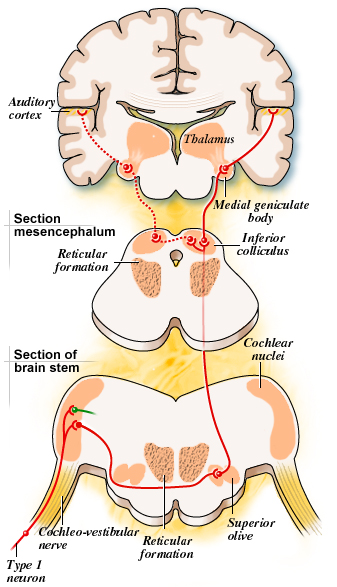Central auditory processing
We have deal with the anatomy of the auditory periphery and how the fundamental attributes of sound are coded in the auditory periphery. A big deal of additional processing occurs in the neural centres which lie in the auditory brainstem and cerebral cortex. As localization and other binaural perceptions based on the interaction of information arriving at the two ears, we require to study the central auditory centres, as auditory nerves from the two cochleae interact only at the brainstem and cerebral cortex. This part deals with the structure and function of the central auditory nervous system (CANS).
Within the brainstem nearly all fibres of the auditory nerve synapse on cells of the cochlear nucleus.

Once they depart the cochlear nucleus, nearly all of the axons of the cochlear nucleus cells cross over to the opposite side (i.e., contralateral side) of the brain. This means that most of the auditory information processed by each half of the brain comes from the ear on the other side of the head. This is in disparity to that found in the visual system, where ganglion cell fibres either stay or cross on similar side of the brain in equivalent proportions. Both crossed and uncrossed fibres from the cochlear nuclei synapse in the region of the brainstem known as the superior olivary complex. This is the initial place in the ascending pathway to receive information from both ears. The neural impulses are transmitted from the superior olivary complex to the inferior colliculus via and/or around the lateral lemniscus (a few fibres synapse in the lateral lemniscus though most travel through it to the lower colliculus), from there to the medial geniculate body and lastly to the auditory cortex.